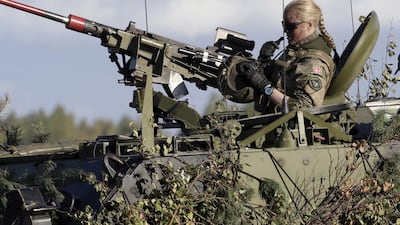When a former deputy commander of Nato warns that the West is on course for armed conflict with Russia within the next year, and China’s vice foreign minister announces that should the United States “stir up any conflict” his country is ready for a “replay” of the Korean and Vietnam wars, one thing should be very clear: the world urgently needs a new security architecture.
Danger of escalation
Across the continents, from the quagmire of competing and often contradictory participants in Syria and Iraq, to the Baltic states and to the seas of the Asia Pacific, the potential for conflict and escalation is rising dangerously.
As well as the scenario outlined by Gen Sir Richard Shirreff – nuclear war in the event of a Russian invasion of Latvia – Nato has been drawn perilously close to the brink with Russia because of Turkey. The two countries actively support different sides in the Syrian conflict, and Turkish forces shot down a Russian warplane last November.
The paradox
The paradox – and the fear – is that the alliance, whose credibility rests on an attack on one being considered an attack on all, could be tested by a state that under its current leader and trajectory would probably never have been invited to join in the first place.
One might have thought this was a time for Nato to take a step back, consolidate and think what its raison d’être is today. Instead it is going full steam ahead and inviting Montenegro to join – another move that, given its historic leadership of the Slavic nations, infuriates Russia.
When the move was raised last December, Admiral Vladimir Komoyedov, chairman of the Russian parliament’s defence committee, said: “They are ready to admit even the North Pole to Nato just for the sake of encircling Russia.” But even so angry a response had no apparent effect: last Thursday the official protocol for Montenegro to join was signed by Nato foreign ministers in Brussels.
Many European member states refuse to spend the appropriate amount of GDP on defence – they are indeed “free riding” on the US, as Barack Obama said. The then US defence secretary, Robert Gates, pointed this out in a blistering speech in 2011 when the Anglo-French led campaign in Libya began to run out of munitions after only 11 weeks.
“Future US political leaders,” he said, “may not consider the return on America’s investment in Nato worth the cost.”
Donald Trump is not alone in echoing that. He was joined by Republican senators who gave Nato secretary general Jens Stoltenberg a very hard time in a private meeting in Washington last month. And yet the reckless sabre-rattling continues.
The Asian scenario
In Asia, meanwhile, western allies are deeply divided in their approach to China. The UK and other European countries see trade as the most important issue, signing up to the Asian Infrastructure Investment Bank against Washington’s wishes, for instance.
But tension is rising seriously between China and the US over claims in the South China Sea. Many countries in the region are deeply worried about it. Some wish to stand up for their claims against Chinese encroachment but worry whether the US is a dependable ally. “The Americans always leave in the end” was a comment I heard recently, citing Vietnam as a prime example.
Mixed signals
There are US officials who acknowledge this, such as Daniel Russel, assistant secretary of state for Asia, who told The New York Times this week that “Asian countries are prone to anxiety about the behaviour of major powers, for good reasons”.
But at the same time, American leaders have been sending mixed signals. Hillary Clinton previously hailed the Trans-Pacific Partnership trade agreement, saying it “binds our countries together, increases stability and promotes security”. Now, however, she is against it. Domestic opposition evidently overrides the need to promote stability and security in the Asia Pacific – a volte-face that will not have gone unnoticed by US allies in the region.
Another school of thought says US interference in the region, such as its insistence on its right to send navy vessels through waters China considers its own, is the cause of the problem. This backs Chinese leaders into a corner, goes the argument, so they have to amp up the rhetoric and the retaliation, lest they seem less than patriotic.
Old arrangement
If war in Europe and naval conflict in Asian waters are closer than they have been for decades, then existing security arrangements cannot be working. It would be perilous to let them be straitjackets on a future they appear to be putting at risk.
Optimists may argue that cold peace will generally prevail as, however bitterly opposed they may be over issues of influence and territory, states will be prevented from warring by trade interests. But such coexistence is brittle and requires more effort than is currently being made; and it didn’t prevent Russia from annexing Crimea.
Need for an alternative
For peace to be lasting, the world needs a new rules-based international system that reflects the new and emerging world order. This would be not just for reasons of realpolitik, but also to recognise that rising and resurgent powers – China and Russia in particular – are justified in resenting the current global architecture. They were excluded from building it. They need to play major roles in writing the new rules.
It is clear that they do not respect the current ones, and feel free to disregard them as they wish. They need to help build and then be bound by a new international security architecture – if the confrontations of the Cassandras are not to become self-fulfilling prophecies.
Sholto Byrnes is a senior fellow at the Institute of Strategic and International Studies, Malaysia


